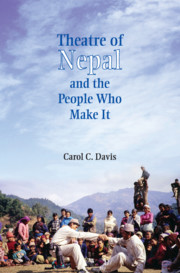Book contents
- Frontmatter
- Dedication
- Contents
- List of Figures
- Acknowledgements
- Prologue
- 1 From Darkness to Light: Antiquity through the Malla Golden Age
- 2 Ruthless Rulers: The Rise of the Shah and the Rana Takeover
- 3 The Drama of Nationalism: Sama Engaged
- 4 Modernism's Advance: Post-Sama Dramatists
- 5 The Pro-Democracy Movement: Ashesh Malla Takes to the Streets
- 6 Cultivating Theatre Aesthetics: Sunil Pokharel's Vision
- 7 Diaspora: Urban Theatre Outside the Capital
- 8 Legacy: Contemporary Theatre in the Kathmandu Valley
- Bibliography
- Index
Prologue
Published online by Cambridge University Press: 26 April 2019
- Frontmatter
- Dedication
- Contents
- List of Figures
- Acknowledgements
- Prologue
- 1 From Darkness to Light: Antiquity through the Malla Golden Age
- 2 Ruthless Rulers: The Rise of the Shah and the Rana Takeover
- 3 The Drama of Nationalism: Sama Engaged
- 4 Modernism's Advance: Post-Sama Dramatists
- 5 The Pro-Democracy Movement: Ashesh Malla Takes to the Streets
- 6 Cultivating Theatre Aesthetics: Sunil Pokharel's Vision
- 7 Diaspora: Urban Theatre Outside the Capital
- 8 Legacy: Contemporary Theatre in the Kathmandu Valley
- Bibliography
- Index
Summary
Kathmandoo, March 1844
We left Chitlang on January 20th after breakfast, and after two or three hours march over the hills we came to a crest of a range, and below us lay the valley of Nepal. It was unlike anything I ever saw, more like an artificial model than any actual scenery and suggested a crowd of new and strange ideas. How did we ever get here? How shall we ever get away? How could this ‘emerald set in the ring of the hills’ have been first discovered and inhabited? And being known at all how comes it to be so little known? What sort of a world shall we find when we descend?1
—Honoria LawrenceIt may seem odd to begin a book about the theatre of Nepal with a quote from the first Western woman ever to enter Nepal, but, like Honoria Lawrence, I, too, am an outsider, a bidesi mahilaa, a foreign woman. Like that Victorian lady, I wondered what I should find in Nepal, what mysteries should unfold. For both of us, what at first seemed foreign and exotic became familiar and friendly. I fell in love with the country on my first trip there—the spectacular scenery, the diverse cultures, the ‘new and strange ideas’, and most of all, the people.
In the ensuing years I came to practice, study, and respect Nepali theatre. I follow the quote from Lawrence's diary with a quote from my own journal:
Arupokhari, 20 April 1996
This steep ascent feels never-ending: we climb up and up, still up and ever up. It is hot. It is humid. I am exhausted. I am out of breath. Sweat is soaking back and pack.
We pass chortens, pass chautaaras, pass terraced rice fields too steeply stacked—how can anyone work on them, how can anyone eke out an existence in this steep, thirsty, dusty terrain? Eventually we pass people on the trail; we pass glances and glares, pass questioning looks and suspicious stares. Finally, we arrive at this little village, so small, so parched: a fetid lake in the baking sun, no shops, only scattered mud-brick homes and a school, a small mud-floored school with a corrugated tin roof that bakes the students when it's hot, freezes them when cold.
- Type
- Chapter
- Information
- Theatre of Nepal and the People Who Make It , pp. xiii - xxiiPublisher: Cambridge University PressPrint publication year: 2019

